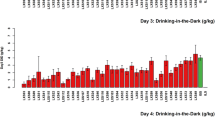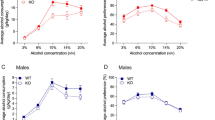Abstract
The aim of this study was the application of a phenotype-driven N-ethyl-N-nitrosourea (ENU) mutagenesis screen in mice for the identification of dominant mutations involved in the regulation and modulation of alcohol-drinking behavior. The chemical mutagen ENU was utilized in the generation of 131 male ENU-mutant C57BL/6J mice (G0). These ENU-treated mice were paired with wild-type C57BL/6J mice to generate G1 and subsequent generations. In total, 3327 mice were generated. Starting with G1, mice were screened for voluntary oral self-administration of 10% (v/v) alcohol vs. water in a two-bottle paradigm. From these mice, after a total period of 5 weeks of drinking, 43 mutants fulfilled the criteria of an “alcohol phenotype,” that is, high or low ethanol intake. They were then selected for breeding and tested in a “confirmation cross” (G2–G4) for inheritance. Although we did not establish stable high or low drinking lines, several results were obtained in the context of alcohol consumption. First, female mice drank more alcohol than their male counterparts. Second, the former demonstrated greater infertility. Third, all animals displayed relatively stable alcohol intake, although significantly different in two different laboratories. Finally, seasonal and monthly variability was observed, with the highest alcohol consumption occurring in spring and the lowest in autumn. In conclusion, it seems difficult to identify dominant mutations involved in the modulation or regulation of voluntary alcohol consumption via a phenotype-driven ENU mutagenesis screen. In accordance with the findings from knockout studies, we suggest that mainly recessive mutations contribute to an alcohol-drinking or alcohol-avoiding phenotype.



Similar content being viewed by others
References
Aksoy A, Schulz D, Yilmaz A, Canbeyli R (2004) Seasonal variability in behavioral despair in female rats. Int J Neurosci 12:1513–1520
Barbaric I, Wells S, Russ A, Dear TN (2007) Spectrum of ENU-induced mutations in phenotype-driven and gene-driven screens in the mouse. Environ Mol Mutagen 48:124–142
Chester JA, de Paula Barrenha G, DeMaria A, Finegan A (2006) Different effects of stress on alcohol drinking behaviour in male and female mice selectively bred for high alcohol preference. Alcohol Alcohol 41:44–53
Crabbe JN, Wahlsten D, Dudek BC (1999) Genetics of mouse behavior: interactions with laboratory environment. Science 284:1670–1672
Crabbe JC, Phillips TJ, Harris RA, Arends MA, Koob GF (2006) Alcohol-related genes: contributions from studies with genetically engineered mice. Addict Biol 11:195–269
Del Rio MC, Prada C, Alvarez FJ (2002) Drinking habits throughout the seasons of the year in the Spanish population. J Stud Alcohol 63:577–580
Hrabé de Angelis M, Flaswinkel H, Fuchs H, Rathkolb B, Soewarto D, et al. (2000) Genome-wide, large-scale production of mutant mice by ENU mutagenesis. Nat Genet 25:444–447
Justice MJ, Carpenter DA, Favor J, Neuhauser-Klaus A, Hrabé de Angelis M, et al. (2000) Effects of ENU dosage on mouse strains. Mamm Genome 11:484–488
Lemmens PH, Knibbe RA (1993) Seasonal variation in survey and sales estimates of alcohol consumption. J Stud Alcohol 54:157–163
Melo JA, Shendure J, Pociask K, Silver LM (1996) Identification of sex-specific quantitative trait loci controlling alcohol preference in C57BL/6 mice. Nat Genet 13:147–153
Meyer L, Caston J, Mensah-Nyagan AG (2006) Seasonal variation of the impact of a stressful procedure on open field behaviour and blood corticosterone in laboratory mice. Behav Brain Res 167:342–348
Middaugh LD, Kelley BM, Bandy ALE, McGroarty KK (1999) Ethanol consumption by C57BL/6 mice: influence of gender and procedural variables. Alcohol 17:175–183
Middaugh LD, Szumlinski KK, Van Patten Y, Marlowe ALB, Kalivas PW (2003) Chronic ethanol consumption by C57BL/6 mice promotes tolerance to its interoceptive cues and increases extracellular dopamine, an effect blocked by naltrexone. Alcohol Clin Exp Res 27:1892–1900
Naz RK, Rajesh C (2005) Gene knockouts that cause female infertility: search for novel contraceptive targets. Front Biosci 10:2447–2459
Nolan PM, Peters J, Strivens M, Rogers D, Hagan J, et al. (2000) A systematic, genome-wide, phenotype-driven mutagenesis programme for gene function studies in the mouse. Nat Genet 25:440–443
Pawlak CR, Schwarting RK (2002) Object preference and nicotine consumption in rats with high vs. low rearing activity in a novel open field. Pharmacol Biochem Behav 73:679–687
Rossant J (2003) Genetics: a balancing act. Nature 425:29–32
Sanchis-Segura C, Spanagel R (2006) Behavioural assessment of drug reinforcement and addictive features in rodents: an overview. Addict Biol 11:2–38
Soewarto D, Blanquet V, Hrabé de Angelis M (2003) Random ENU mutagenesis. Methods Mol Biol 209:249–266
Spanagel R, Sigmund S, Cowen M, Schroff KC, Schumann G, et al. (2002) The neuronal nitric oxide synthase (nNOS) gene is critically involved in neurobehavioral effects of alcohol. J Neurosci 22:8676–8683
Uitenbroek DG (1996) Seasonal variation in alcohol use. J Stud Alcohol 57:47–52
Wahlsten D, Metten P, Phillips TJ, Boehm SL II, Burkhart-Kasch S, et al. (2003) Different data from different labs: lessons from studies of gene-environment interaction. J Neurobiol 54:283–311
Acknowledgments
We thank Mark Lathrop for initiating this project, and Martina Herforth, Sabrina Koch, Stefanie Frank, and Peter Siegel for excellent technical assistance. This work was supported by BMBF grants FKZ 01GS0475 and 01 EB 0410 and the Centre National de Génotypage, Evry, France.
Author information
Authors and Affiliations
Corresponding author
Rights and permissions
About this article
Cite this article
Pawlak, C.R., Sanchis-Segura, C., Soewarto, D. et al. A phenotype-driven ENU mutagenesis screen for the identification of dominant mutations involved in alcohol consumption. Mamm Genome 19, 77–84 (2008). https://doi.org/10.1007/s00335-007-9087-4
Received:
Accepted:
Published:
Issue Date:
DOI: https://doi.org/10.1007/s00335-007-9087-4




